A Cycle Slip Repair Method Against Ionospheric Effects and Observational Noises for BDS Triple-Frequency Undifferenced Phases
Abstract
1. Introduction
2. Method
2.1. Cycle Slip Presentation and Analyzation
2.2. Ionospheric Correction and Its Precision
2.3. Optimization of Cycle Slip Solution from Minimizing the Total Noises after Ionospheric Correction
2.4. Cycle Slip Solution
2.5. Cycle Slip Repair Against Pseudorange Error
2.6. Repair Result Checking
3. Test Description
4. Experimental Results and Analysis
4.1. Results of BTCSR Against the Small and Special Cycle Slip
4.2. Results of BTCSR Against the Severe Ionospheric Variation
4.3. Results of BTCSR Against the Large Pseudorange Error
5. Conclusions
- (1)
- On the basis of correcting the influence of the ionospheric variation, the effect of the residual ionospheric error after the correction of CSR is further minimized. Under the condition that the second-order difference of the ionospheric delay approaches 0, the first-order difference of the ionospheric delay at the previous epoch is used to correct the variation of ionospheric delay at the current epoch. After the ionospheric variation is corrected, the residual ionospheric influence is optimized. By minimizing the variance of the combined cycle slip, an optimal model of calculating cycle slip combination is formed, which also covers targets such as the smaller amplification effect of ionospheric correction error. Then, the calculation method is supplied for the combined cycle slip with the root mean squared errors of (0.0646,0.1261,0.1069) cycles, resulting in CSR success rate of 99.9927%, the ionospheric amplification coefficients with respect to cycle units of (0,12.0345,11.7112), and the wavelengths of (4.8842,3.5738,8.1403) m.
- (2)
- The cycle slips provided by CTCSR have been further selected by BTCSR, and the CSR reliability is improved by eliminating the influence of larger pseudorange errors on determining the correct cycle slip. The large pseudorange error may lead to a significant deviation of the combined cycle slip calculated from the combination of phases and pseudoranges. When the deviation of the combined cycle slip from the correct integer is larger than 0.5, it easily causes the combined cycle slip to be fixed as an improper value that is discrepant from the actual correct value. In order to deal with the influence of significant deviation resulting from the large pseudorange error on the cycle slip fixing, BTCSR sets up a discriminant function. The candidates of cycle slip values are sorted according to the absolute epoch-difference value of the ionosphere-free and geometry-free phase, where the cycle slip corresponding to the minimum absolute value is selected as the final repair value. Since the discriminant function eliminates the interference of pseudorange error and ionospheric delay on determining the actual cycle slip, the CSR correctness is guaranteed, and the reliability is improved.
Supplementary Materials
Author Contributions
Funding
Conflicts of Interest
References
- Feng, Y. GNSS three carrier ambiguity resolution using ionosphere-reduced virtual signals. J. Geod. 2008, 82, 847–862. [Google Scholar] [CrossRef]
- Feng, Y.; Rizos, C. Network-based geometry-free three carrier ambiguity resolution and phase bias calibration. GPS Solut. 2008, 13, 43–56. [Google Scholar] [CrossRef]
- Ge, M.; Gendt, G.; Rothacher, M.; Shi, C.; Liu, J. Resolution of GPS carrier-phase ambiguities in Precise Point Positioning (PPP) with daily observations. J. Geod. 2008, 82, 401. [Google Scholar] [CrossRef]
- Leick, A. GPS Satellite Surveying, 3rd ed.; Wiley: Hoboken, NJ, USA, 2004. [Google Scholar]
- Yang, Y.; Li, J.; Xu, J.; Tang, J.; Guo, H.; He, H. Contribution of the Compass satellite navigation system to global PNT users. Chin. Sci. Bull. 2011, 56, 2813–2819. [Google Scholar] [CrossRef]
- Chen, D.; Ye, S.R.; Xu, C.; Jiang, W.; Li, S.; Xia, P.; Jiang, P. A method for the repair of cycle slip using double-differenced velocity estimation for GNSS RTK positioning. Adv. Space Res. 2019, 63, 2809–2821. [Google Scholar] [CrossRef]
- Kosarev, N.S.; Antonovich, K.M.; Lipatnikov, L. The method of cycle-slip detection and repair GNSS meaturements by using receiver with high stability frequency oscillator. Contrib. Geophys. Geod. 2019, 49, 283–301. [Google Scholar] [CrossRef]
- Liu, Z. A new automated cycle slip detection and repair method for a single dual-frequency GPS receiver. J. Geod. 2010, 85, 171–183. [Google Scholar] [CrossRef]
- Yang, F.; Zhao, L.; Li, L.; Cheng, J.; Zhang, J. Ionosphere-Constrained Triple-Frequency Cycle Slip Fixing Method for the Rapid Re-Initialization of PPP. Sensors 2018, 19, 117. [Google Scholar] [CrossRef]
- Zhao, Q.; Sun, B.; Dai, Z.; Hu, Z.; Shi, C.; Liu, J. Real-time detection and repair of cycle slips in triple-frequency GNSS measure-ments. GPS Solut. 2015, 19, 381–391. [Google Scholar] [CrossRef]
- Blewitt, G. An Automatic Editing Algorithm for GPS data. Geophys. Res. Lett. 1990, 17, 199–202. [Google Scholar] [CrossRef]
- Bisnath, S.B. Efficient, automated cycle slip correction of dual-frequency kinematic GPS data. In Proceedings of the ION GPS 2000, Salt Lake City, UT, USA, 19–22 September 2000; pp. 145–154. [Google Scholar]
- Melbourne, W.G. The case for ranging in GPS based geodetic systems. In Proceedings of the 1st International Symposium on Precise Positioning with the Global Positioning System, Rockville, ML, USA, 15–19 April 1985; pp. 373–386. [Google Scholar]
- Kim, D.; Langley, R.B. Instantaneous real-time cycle slip correction of dual frequency GPS data. In Proceedings of the International Symposium on Kinematic Systems in Geodesy, Geomatics and Navigation, Banff, AB, Canada, 5–8 June 2001; pp. 255–264. [Google Scholar]
- Ji, S.; Chen, W.; Zhao, C.; Ding, X.; Chen, Y. Single epoch ambiguity resolution for Galileo with the CAR and LAMBDA methods. GPS Solut. 2007, 11, 259–268. [Google Scholar] [CrossRef]
- Teunissen, P.J.G. The least-squares ambiguity decorrelationadjustment: A method for fast GPS integer ambiguity estimation. J. Geod. 1995, 70, 65–82. [Google Scholar] [CrossRef]
- Zhang, X.; Li, X. Instantaneous re-initialization in real-time kinematic PPP with cycle slip fixing. GPS Solut. 2012, 16, 315–327. [Google Scholar]
- Zhang, X.; Li, P. Benefits of the third frequency signal on cycle slip correction. GPS Solut. 2015, 20, 451–460. [Google Scholar] [CrossRef]
- Qian, C.; Liu, H.; Zhang, M.; Shu, B.; Xu, L.; Zhang, R. A Geometry-Based Cycle Slip Detection and Repair Method with Time-Differenced Carrier Phase (TDCP) for a Single Frequency Global Position System (GPS) + BeiDou Navigation Satellite System (BDS) Receiver. Sensors 2016, 16, 2064. [Google Scholar] [CrossRef]
- De Lacy, M.C.; Reguzzoni, M.; Sansò, F.; Venuti, G. The Bayesian detection of discontinuities in a polynomial regression and its application to the cycle-slip problem. J. Geod. 2008, 82, 527–542. [Google Scholar] [CrossRef]
- Cai, C.; Liu, Z.; Xia, P.; Dai, W. Cycle slip detection and repair for undifferenced GPS observations under high ionospheric activity. GPS Solut. 2012, 17, 247–260. [Google Scholar] [CrossRef]
- Li, T.; Melachroinos, S. An enhanced cycle slip repair algorithm for real-time multi-GNSS, multi-frequency data processing. GPS Solut. 2018, 23, 1. [Google Scholar] [CrossRef]
- Zhao, D.; Hancock, C.; Roberts, G.W.; Jin, S. Cycle Slip Detection during High Ionospheric Activities Based on Combined Triple-Frequency GNSS Signals. Remote. Sens. 2019, 11, 250. [Google Scholar] [CrossRef]
- Cocard, M.; Bourgon, S.; Kamali, O.; Collins, P. A systematic investigation of optimal carrier-phase combinations for modernized triple-frequency GPS. J. Geod. 2008, 82, 555–564. [Google Scholar] [CrossRef]
- De Lacy, M.C.; Reguzzoni, M.; Sansò, F. Real-time cycle slip detection in triple-frequency GNSS. GPS Solut. 2011, 16, 353–362. [Google Scholar] [CrossRef]
- Li, B.; Feng, Y.; Shen, Y. Three carrier ambiguity resolution: Distance-independent performance demonstrated using semi-generated triple frequency GPS signals. GPS Solut. 2009, 14, 177–184. [Google Scholar] [CrossRef]
- Dai, Z.; Knedlik, S.; Loffeld, O. Instantaneous Triple-Frequency GPS Cycle-Slip Detection and Repair. Int. J. Navig. Obs. 2009, 2009, 1–15. [Google Scholar] [CrossRef]
- El-Tokhey, M.; Sorour, T.; Ragheb, A.; Moussa, M. GPS cycle slips detection and repair through various signal Combinations. IJMER 2014, 4, 11. [Google Scholar]
- Huang, L.; Lu, Z.; Zhai, G.; Ouyang, Y.; Huang, M.; Lu, X.; Wu, T.; Li, K. A new triple-frequency cycle slip detecting algorithm validated with BDS data. GPS Solut. 2015, 20, 761–769. [Google Scholar] [CrossRef]
- Liu, W.; Jin, X.; Wu, M.; Hu, J.; Wu, Y. A New Real-Time Cycle Slip Detection and Repair Method under High Ionospheric Activity for a Triple-Frequency GPS/BDS Receiver. Sensors 2018, 18, 427. [Google Scholar] [CrossRef]
- Bagiya, M.S.; Joshi, H.P.; Iyer KNAggarwal, M.; Ravindran, S.; Pathan, B.M. TEC variations during low solar activity period (2005–2007) near the equatorial ionospheric anomaly crest region in India. Ann. Geophycieae 2009, 27, 1047–1057. [Google Scholar] [CrossRef]
- Beach, T.L.; Kelley, M.C.; Kintner, P.M.; Miller, C.A. Total electron content variations due to nonclassical traveling ionospheric disturbances: Theory and Global Positioning System observations. J. Geophys. Res. Space Phys. 1997, 102, 7279–7292. [Google Scholar] [CrossRef]
- Padokhin, A.; Tereshin, N.; Yasyukevich, Y.; Andreeva, E.; Nazarenko, M.; Yasyukevich, A.; Kozlovtseva, E.; Kurbatov, G. Application of BDS-GEO for studying TEC variability in equatorial ionosphere on different time scales. Adv. Space Res. 2019, 63, 257–269. [Google Scholar] [CrossRef]
- Zeng, T.; Sui, L.; Xu, Y.; Jia, X.; Xiao, G.; Tian, Y.; Zhang, Q. Real-time triple-frequency cycle slip detection and repair method under ionospheric disturbance validated with BDS data. GPS Solut. 2018, 22, 62. [Google Scholar] [CrossRef]
- Montenbruck, O.; Hauschild, A.; Steigenberger, P.; Hugentobler, U.; Teunissen, P.J.G.; Nakamura, S. Initial assessment of the COMPASS/BeiDou-2 regional navigation satellite system. GPS Solut. 2012, 17, 211–222. [Google Scholar] [CrossRef]
- Xu, G.C. GPS Theory, Algorithms and Applications; Springer: Berlin/Heidelberg, Germany, 2007. [Google Scholar]
- Yuan, Y.; Huo, X.; Ou, J.; Zhang, K.; Chai, Y.; Wen, D.; Grenfell, R. Refining the Klobuchar ionospheric coefficients based on GPS observations. IEEE Trans. Aerosp. Electron. Syst. 2008, 44, 1498–1510. [Google Scholar] [CrossRef]
- Galav, P.; Rao, S.S.; Sharma, S.; Gordiyenko, G.; Pandey, R. Ionospheric response to the geomagnetic storm of 15 May 2005 over mid latitudes in the day and night sectors simultaneously. J. Geophys. Res. Space Physics. 2014, 119, 1–12. [Google Scholar]
- Odijk, D. Fast Precise GPS Positioning in the Presence of Ionospheric Delays, NCG Series. Ph.D. Thesis, Delft University of Technology, Delft, The Netherlands, 2002. [Google Scholar]
- Shinagawa, H.; Iyemori, T.; Saito, S.; Maruyama, T. A numerical simulation of ionospheric and atmospheric variations associated with the Sumatra earthquake on 26 December 2004. Earth Planets Space 2007, 59, 1015–1026. [Google Scholar] [CrossRef]
- Simsky, A. Three’s the Charm: Three-frequency Combinations in Future GNSS. Inside GNSS 2006, 1, 38–41. [Google Scholar]
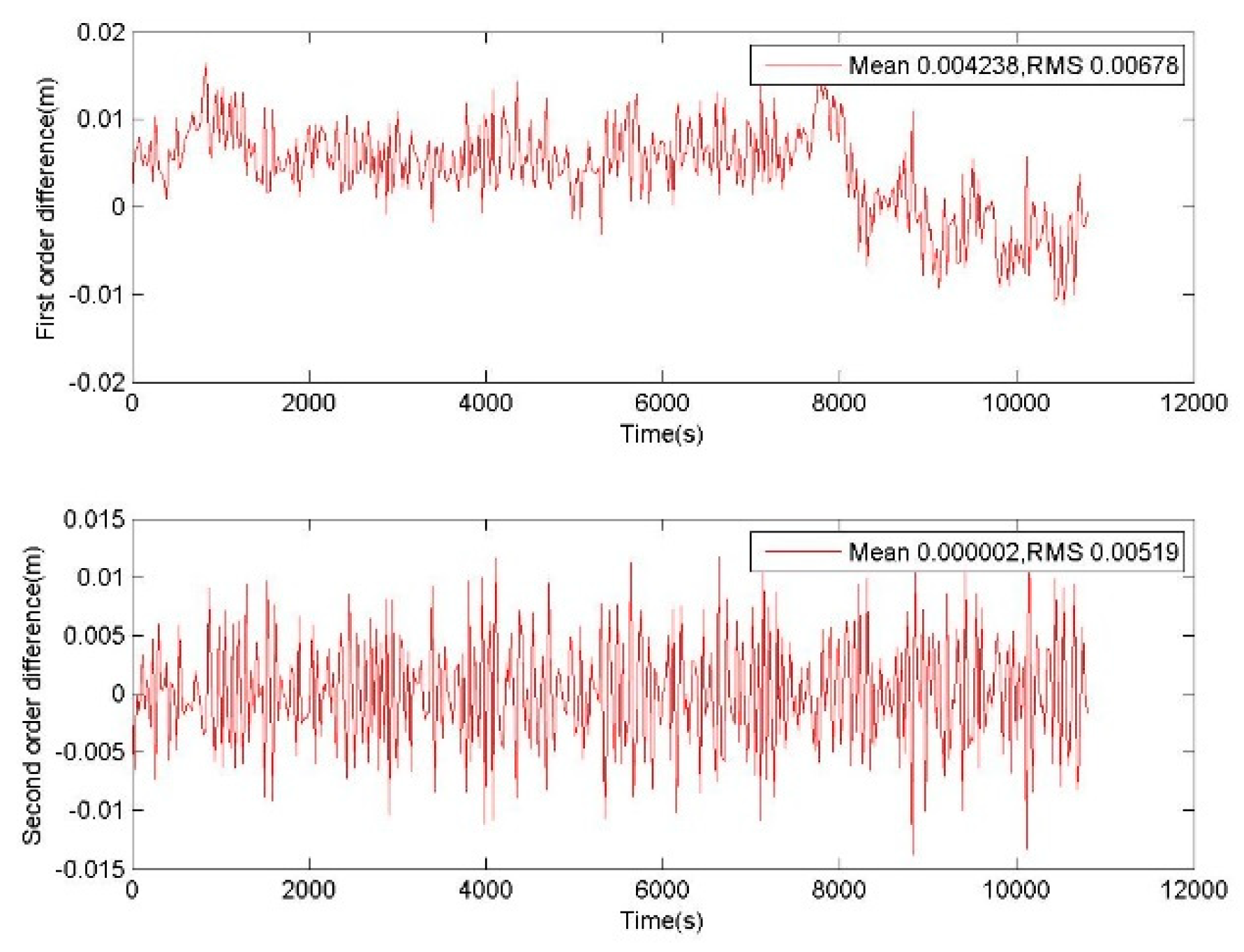

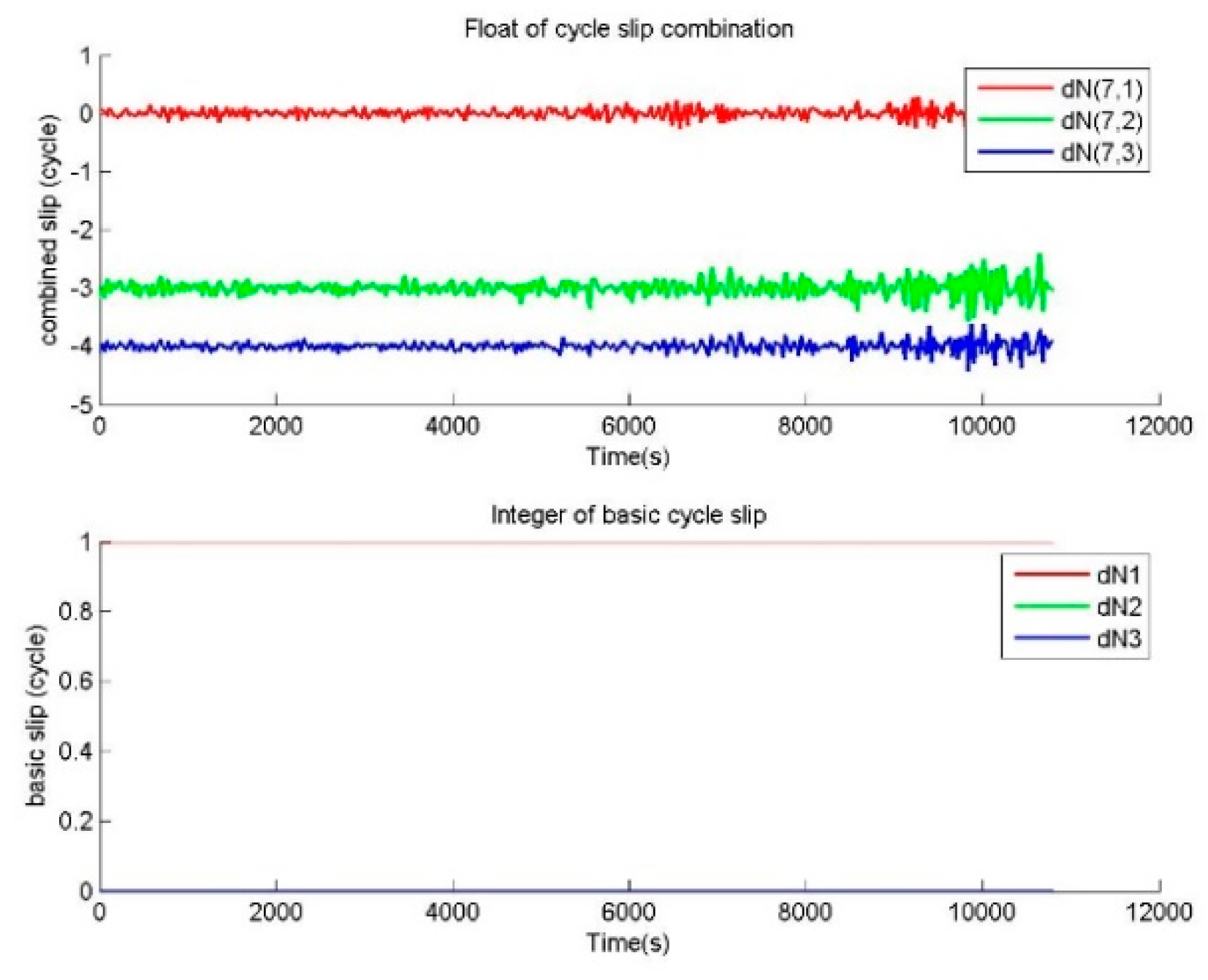



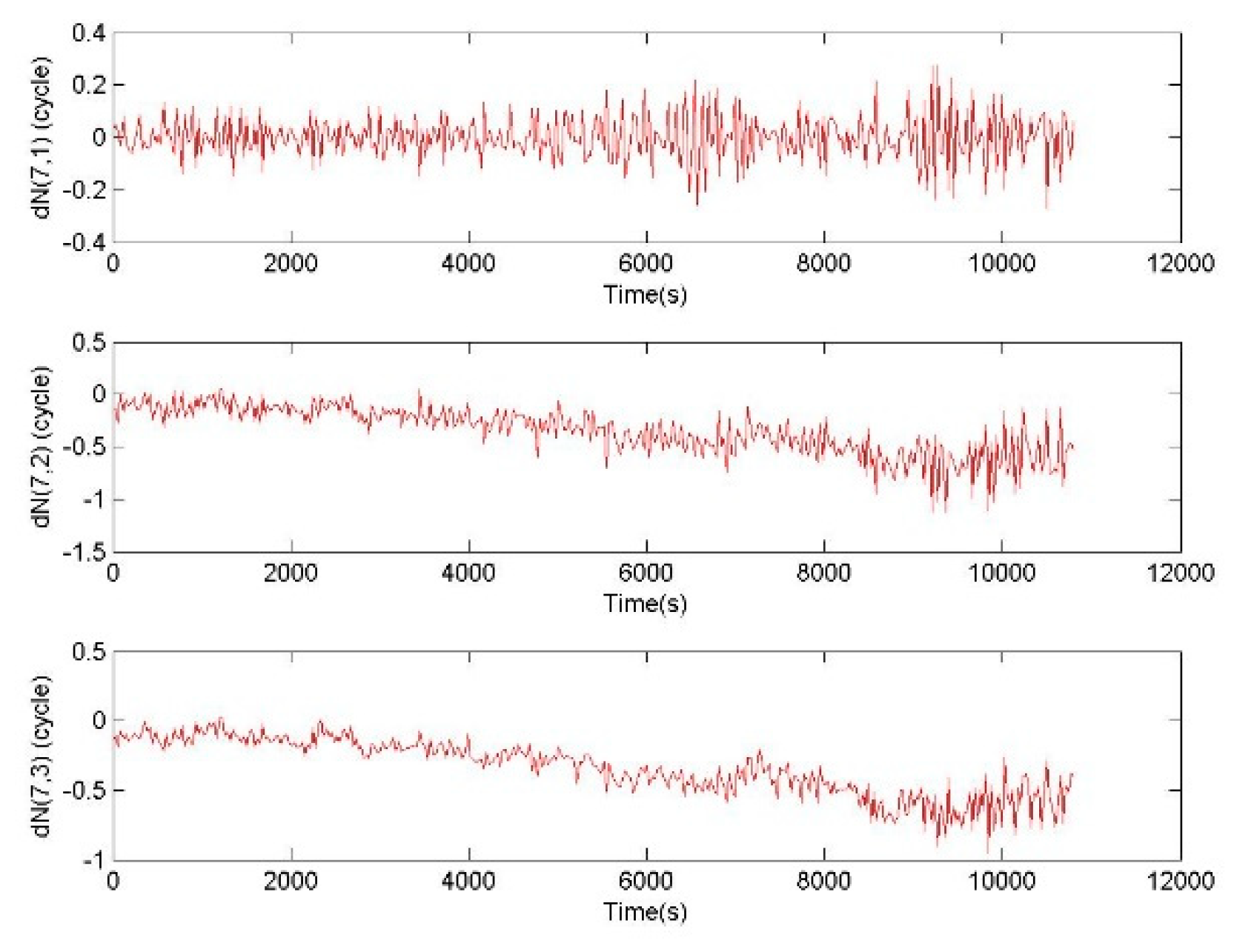
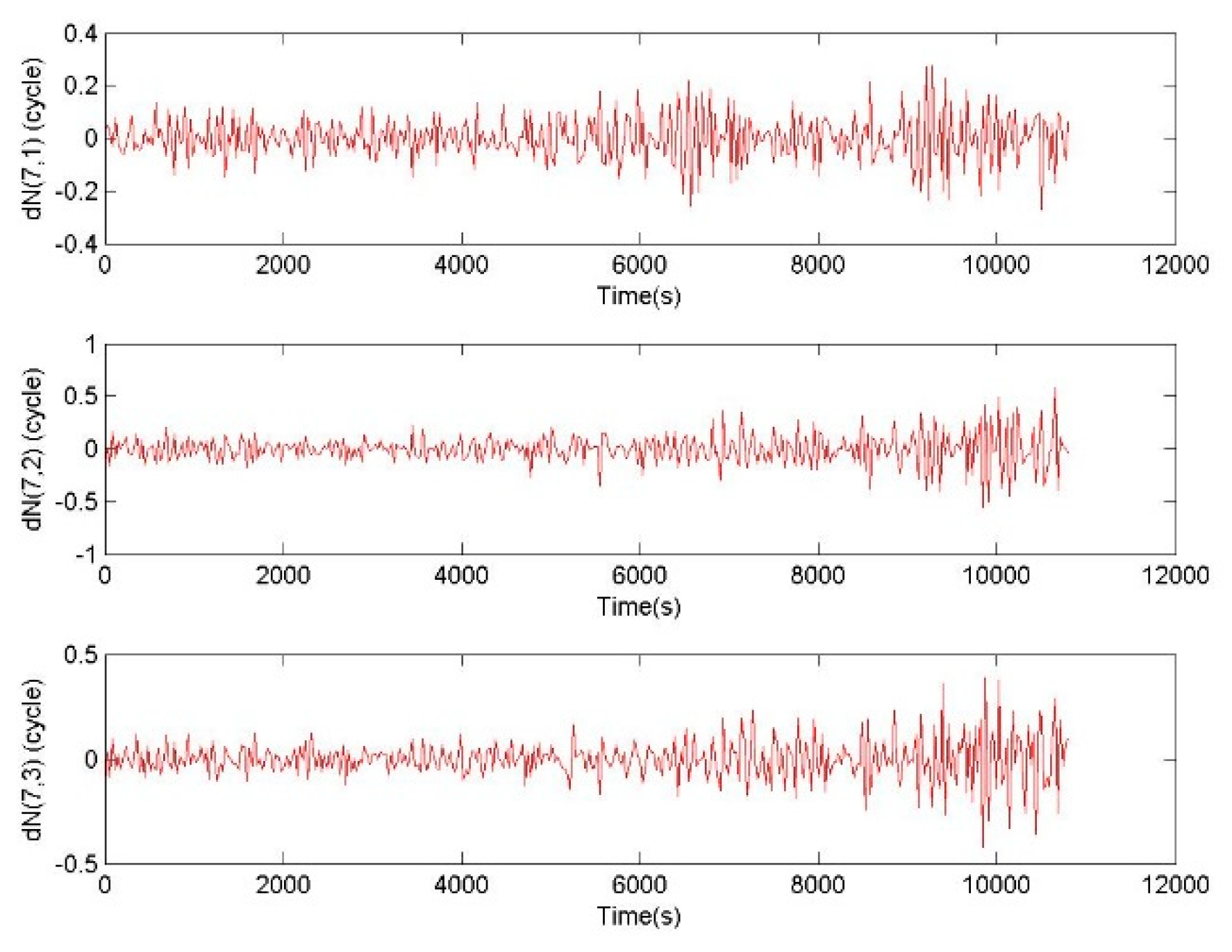


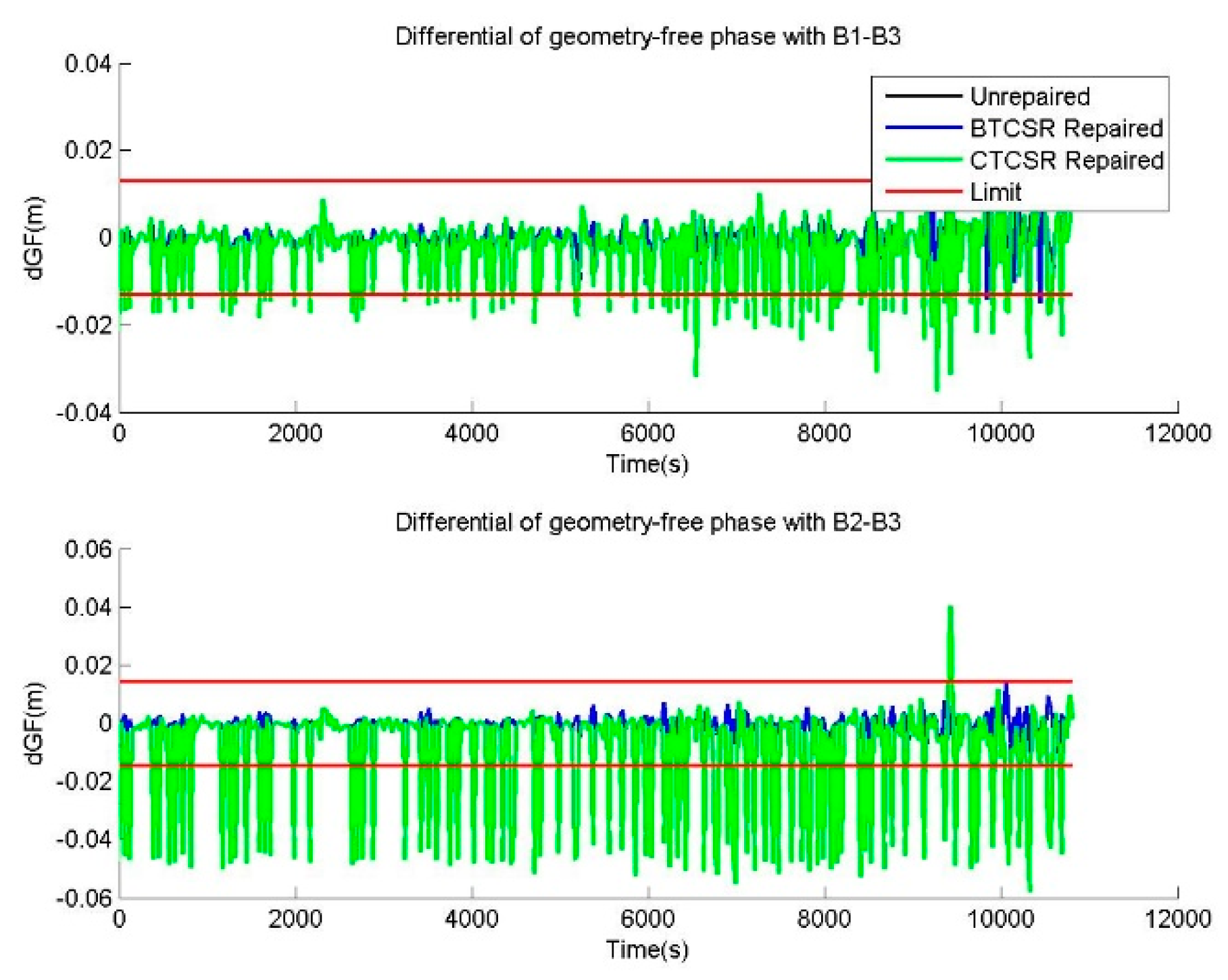


(wrt: B1,cycle) | |||||
|---|---|---|---|---|---|
| 0, −1,1 | 4.8842 | 0.0141 | −0.3258 | 0.0457 | |
| −3, 5, −1 | 3.5738 | 0.0592 | 11.6406 | 0.0768 | |
| −4, 1, 4 | 8.1403 | 0.0574 | 11.5382 | 0.0613 |
(wrt: B1, m) | (wrt: B1, cycle) | ||||
|---|---|---|---|---|---|
| 0,0.48760330578513, 0.51239669421487 | 0.2122 | 1.5915 | 0 | 0.0646 | |
| 0.3, 0.3, 0.4 | 0.1749 | 1.4075 | 12.0345 | 0.1261 | |
| 0.3, 0.3, 0.4 | 0.1749 | 1.4075 | 11.7112 | 0.1069 |
© 2020 by the authors. Licensee MDPI, Basel, Switzerland. This article is an open access article distributed under the terms and conditions of the Creative Commons Attribution (CC BY) license (http://creativecommons.org/licenses/by/4.0/).
Share and Cite
Li, D.; Mi, J.; Cheng, P.; Yuan, Y.; Gan, X. A Cycle Slip Repair Method Against Ionospheric Effects and Observational Noises for BDS Triple-Frequency Undifferenced Phases. Sensors 2020, 20, 2819. https://doi.org/10.3390/s20102819
Li D, Mi J, Cheng P, Yuan Y, Gan X. A Cycle Slip Repair Method Against Ionospheric Effects and Observational Noises for BDS Triple-Frequency Undifferenced Phases. Sensors. 2020; 20(10):2819. https://doi.org/10.3390/s20102819
Chicago/Turabian StyleLi, Dehai, Jinzhong Mi, Pengfei Cheng, Yunbin Yuan, and Xingli Gan. 2020. "A Cycle Slip Repair Method Against Ionospheric Effects and Observational Noises for BDS Triple-Frequency Undifferenced Phases" Sensors 20, no. 10: 2819. https://doi.org/10.3390/s20102819
APA StyleLi, D., Mi, J., Cheng, P., Yuan, Y., & Gan, X. (2020). A Cycle Slip Repair Method Against Ionospheric Effects and Observational Noises for BDS Triple-Frequency Undifferenced Phases. Sensors, 20(10), 2819. https://doi.org/10.3390/s20102819






